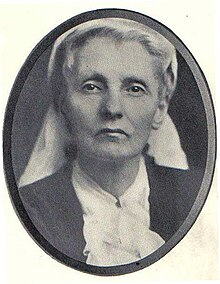Victoria Welby

Victoria Welby-Gregory , née Victoria Alexandrina Maria Louisa Stuart-Wortley (born April 27, 1837 - March 29, 1912 in Harrow ), was a British philosopher. She is particularly known for her work on the theory of linguistic meaning and for the justification of significant .
Life
Victoria Welby was born the youngest daughter of the British politician Charles Stuart-Wortley , a son of James Stuart-Wortley, 1st Baron Wharncliffe , and his wife, Lady Emmeline Stuart-Wortley , a daughter of John Manners, 5th Duke of Rutland . She did not receive any schooling, but was raised only by private tutors. After the death of her father in 1844, she accompanied her mother from 1848 to 1855 on extensive trips through the United States, Canada , Mexico , Spain , Morocco , the Ottoman Empire and many other countries. She published her travel diary as early as 1852. After her mother's death in 1855, she lived with relatives before her godmother, the Duchess of Kent , took her into her household. In 1861 she became the maid of honor of Queen Victoria , the daughter of her godmother. She lived at the royal court for the next two years before she married the politician William Earle Welby on July 4, 1863 . After their marriage, she left the royal court and moved to Denton Manor near Grantham . Her husband inherited the title of Baronet after the death of his father in 1875 and changed his name to Welby-Gregory , thus Welby received the courtesy title of Lady Welby-Gregory .
She had several children with her husband:
- Victor Albert William Welby (1864–1876)
- Charles Glynne Earle Welby (1865-1938)
- Emmeline Mary Elizabeth (Nina) Welby (1867–1955) ⚭ Henry Cockayne-Cust
At the end of January 1912 she fell ill with influenza , whereupon she suffered from partial aphasia and paralysis of her right hand. A little later she died in Duneaves, Mount Park in Harrow near London.

plant
After her marriage, Welby devoted herself to her studies with the full support of her husband. In self-study, Welby taught herself the basics of her general education and specialist knowledge in theology and philosophy and eventually gained access to the most important philosophical journals in England. There she began to publish works on the philosophy of language, which were included in her first book on the philosophy of language, What Is Meaning? (1903), and which laid the foundation for further investigations into the various ways of using linguistic expressions and the topic of speaker intentions in linguistic communication. She combined her leading questions and theoretical elaborations into a theoretical project called "Significant", which is understood as a fundamental discipline in the philosophy of language. Along with Peirce, she is one of the founding figures of linguistic-philosophical pragmatism .
The review of What Is Meaning? by Charles S. Peirce led to a detailed exchange of letters dealing primarily with problems of Peirce's semiotics. The two thinkers not only share an interest in topics of linguistic philosophy in the broadest sense, but for different reasons each took a marginal position in the philosophical discourse of the time. Through Welby, Peirce's work became known in England and also gave Charles K. Ogden the acquaintance with the works of the American philosopher, which were just as important for Ogden's book The Meaning of Meaning as Welby's writings. The "Nederlandsche Signifische Bewegungsing" ("Dutch Significs Group") founded in 1917 by Frederik van Eeden , to which Gerrit Mannoury and LEJ Brouwer belonged , also referred directly to Welby's approach .
Fonts
- What Is Meaning? Studies in the Development of Significance . London 1903. (Reprint with an introductory essay by Gerrit Mannoury and a preface by Achim Eschbach . John Benjamin, Amsterdam [ua] 1983. [= Foundations of semiotics; 2.])
- Significs and Language. The Articulate Form of Our Expressive and Interpretative Resources . London 1911. (Reprint edited by H. Walter Schmitz, John Benjamin, Amsterdam [ua] 1985. [= Foundations of semiotics; 5.])
- Semiotic and Significs. The Correspondence between Charles S. Peirce and Victoria Lady Welby . Edited by Charles S. Hardwick and James Cook. Indiana Univ. Press, Bloomington (et al.) 1977.
literature
- Susan Petrilli: Signifying and Understanding. Reading the Work of Victoria Welby and the Significant Movement . de Gruyter Mouton, Berlin 2009. (= Semiotics, Communication and Cognition; 2.) (contains numerous reprints of articles and first publications of archive material)
- H. Walter Schmitz: Victoria Lady Welby's Significs: the Origin of the Significant Movement. In: Welby (1985), pp. Ix-ccxxxv.
- H. Walter Schmitz (ed.): Essays on Significs. Papers presented on the occasion of the 150th anniversary of the birth of Victoria Lady Welby (1837 - 1912) . John Benjamin, Amsterdam (ua) 1990. (= Foundations of semiotics; 23.)
Web links
- Susan Petrilli: Welby [afterwards Welby-Gregory; née Stuart-Wortley], Victoria Alexandrina Maria Louisa, Lady Welby (1837–1912). In: Henry Colin Gray Matthew, Brian Harrison (Eds.): Oxford Dictionary of National Biography , from the earliest times to the year 2000 (ODNB). Oxford University Press, Oxford 2004, ISBN 0-19-861411-X , ( oxforddnb.com license required ), as of 2004
- Victoria Alexandrina Maria Louisa Stuart-Wortley-Mackenzie on thepeerage.com , accessed December 6, 2018.
- Literature by and about Victoria Welby in the catalog of the German National Library
Individual evidence
- ↑ Cracroft's Peerage: Wharncliffe, Baron (UK, 1826). Retrieved September 18, 2014 .
| personal data | |
|---|---|
| SURNAME | Welby, Victoria |
| ALTERNATIVE NAMES | Stuart-Wortley, Victoria Alexandrina Maria Louisa (maiden name); Welby-Gregory, Victoria |
| BRIEF DESCRIPTION | British philosopher |
| DATE OF BIRTH | April 27, 1837 |
| DATE OF DEATH | March 29, 1912 |
| Place of death | Harrow |